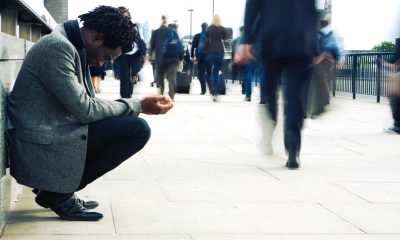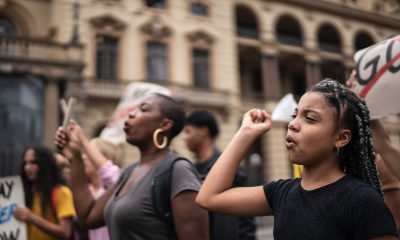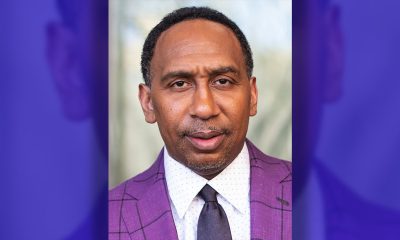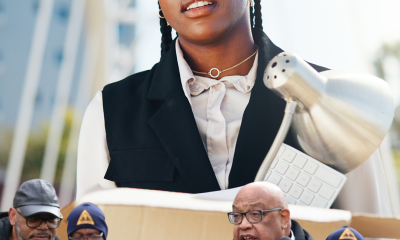Business
Twitter Joins 25×25 Pledge on Diversity in Leadership Positions
The 25×25 Pledge challenges companies to increase their diversity in leadership positions in their companies with a goal of filling 25% of leadership positions with hires from underrepresented groups by 2025 or by making a pledge that leadership roles from underrepresented groups will increase by 25% by the year 2025.

On February 18, 2021, Twitter joined the Silicon Valley Leadership group by signing on to the 25×25 Pledge.
The 25×25 Pledge challenges companies to increase their diversity in leadership positions in their companies with a goal of filling 25% of leadership positions with hires from underrepresented groups by 2025 or by making a pledge that leadership roles from underrepresented groups will increase by 25% by the year 2025.
State law requiring diversity on corporate boards of publicly traded companies defined “underrepresented groups” as someone who self-identifies as Black, African American, Hispanic, Latino, Asian, Pacific Islander, Native American, Native Hawaiian or Alaska Native, or who self-identifies as gay, lesbian, bisexual or transgender.
The self-identify component brings to mind Rachel Dolezal and others who identify as Black but are not, in fact, Black.
“We’re proud to join the 25×25 pledge, which expands on our bold vision for workforce representation and commitment to inclusion and diversity programs to accelerate progress,” said Dalana Brand, vice president of People Experience and head of Inclusion and Diversity at Twitter.
“Twitter’s purpose is to serve the public conversation and we’re committed to making sure our company reflects the diversity of people who use the service.
“Twitter has long been a groundbreaker in Silicon Valley and a driver of the important conversations in our culture. By taking the 25×25 pledge, they propel the conversation of inclusion and show themselves to be one of the most forward-thinking, action-oriented companies in diversity and representation in our industry,” Brand said. “This is all about action to make our leading companies stronger at the end of the day. We’re proud to have them alongside so many of our member companies at this historic moment of reckoning, on diversity and representation.”
Other organizations taking the pledge include Alaska Airlines, Bay Area Council, Equilar, Facebook, Flex, Foothill De Anza College, Listo, Lumentum, NAACP (California & Hawaii), Santa Clara University, San Francisco 49ers, San Francisco Chronicle, Stanford Lucille Packard Children’s Hospital, SunPower, United Airlines, Western Digital and Zoom.
California Sen. Alex Padilla spoke at the Diversity Forward Conference by the Silicon Valley Leadership group on February 19 and said: “[j]ust embracing the dialogue in this and agreeing that it is important to diversify your individual companies and organizations at all levels. If you have something to brag about in terms of diversity, you know, why wait for it to be a mandated requirement for you to report it? Show us where you are and show us the progress that you’re making.”
For more information about 25×25 visit Pledge25x25.org.
The San Francisco Chronicle, Pledge25x25.org and SVLG.org were sources for this report.
Alameda County
Seth Curry Makes Impressive Debut with the Golden State Warriors
Seth looked comfortable in his new uniform, seamlessly fitting into the Warriors’ offensive and defensive system. He finished the night with an impressive 14 points, becoming one of the team’s top scorers for the game. Seth’s points came in a variety of ways – floaters, spot-up three-pointers, mid-range jumpers, and a handful of aggressive drives that kept the Oklahoma City Thunder defense on its heels.

By Y’Anad Burrell
Tuesday night was anything but ordinary for fans in San Francisco as Seth Curry made his highly anticipated debut as a new member of the Golden State Warriors. Seth didn’t disappoint, delivering a performance that not only showcased his scoring ability but also demonstrated his added value to the team.
At 35, the 12-year NBA veteran on Monday signed a contract to play with the Warriors for the rest of the season.
Seth looked comfortable in his new uniform, seamlessly fitting into the Warriors’ offensive and defensive system. He finished the night with an impressive 14 points, becoming one of the team’s top scorers for the game. Seth’s points came in a variety of ways – floaters, spot-up three-pointers, mid-range jumpers, and a handful of aggressive drives that kept the Oklahoma City Thunder defense on its heels.
One of the most memorable moments of the evening came before Seth even scored his first points. As he checked into the game, the Chase Center erupted into applause, with fans rising to their feet to give the newest Warrior a standing ovation.
The crowd’s reaction was a testament not only to Seth’s reputation as a sharpshooter but also to the excitement he brings to the Warriors. It was clear that fans quickly embraced Seth as one of their own, eager to see what he could bring to the team’s championship aspirations.
Warriors’ superstar Steph Curry – Seth’s brother – did not play due to an injury. One could only imagine what it would be like if the Curry brothers were on the court together. Magic in the making.
Seth’s debut proved to be a turning point for the Warriors. Not only did he contribute on the scoreboard, but he also brought a sense of confidence and composure to the floor.
While their loss last night, OKC 124 – GSW 112, Seth’s impact was a game-changer and there’s more yet to come. Beyond statistics, it was clear that Seth’s presence elevated the team’s performance, giving the Warriors a new force as they look to make a deep playoff run.
Activism
Oakland Post: Week of November 26 – December 2, 2025
The printed Weekly Edition of the Oakland Post: Week of November 26 – December 2, 2025

To enlarge your view of this issue, use the slider, magnifying glass icon or full page icon in the lower right corner of the browser window.
Activism
Oakland Post: Week of November 19 – 25, 2025
The printed Weekly Edition of the Oakland Post: Week of November 19 – 25, 2025
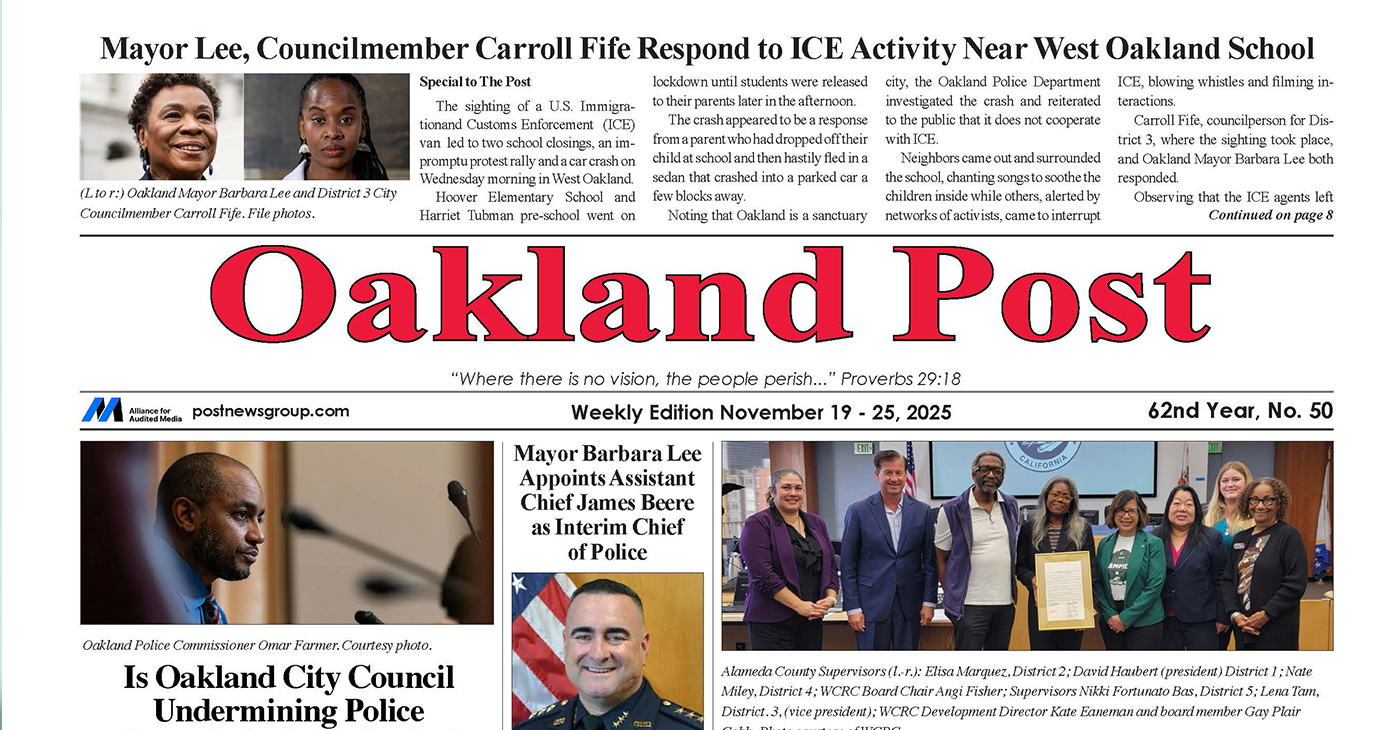
To enlarge your view of this issue, use the slider, magnifying glass icon or full page icon in the lower right corner of the browser window.
-

 Activism3 weeks ago
Activism3 weeks agoOakland Post: Week of November 12 – 18, 2025
-
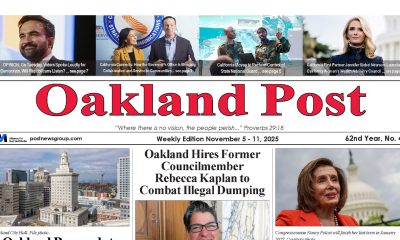
 Activism4 weeks ago
Activism4 weeks agoOakland Post: Week of November 5 – 11, 2025
-

 Activism2 weeks ago
Activism2 weeks agoIN MEMORIAM: William ‘Bill’ Patterson, 94
-

 Activism3 weeks ago
Activism3 weeks agoHow Charles R. Drew University Navigated More Than $20 Million in Fed Cuts – Still Prioritizing Students and Community Health
-

 #NNPA BlackPress3 weeks ago
#NNPA BlackPress3 weeks agoThe Perfumed Hand of Hypocrisy: Trump Hosted Former Terror Suspect While America Condemns a Muslim Mayor
-

 #NNPA BlackPress3 weeks ago
#NNPA BlackPress3 weeks agoProtecting Pedophiles: The GOP’s Warped Crusade Against Its Own Lies
-

 Bay Area3 weeks ago
Bay Area3 weeks agoNo Justice in the Justice System
-
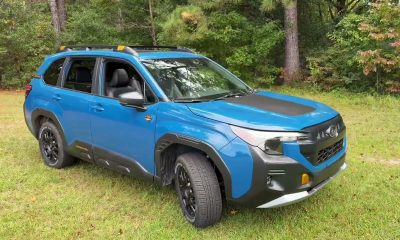
 #NNPA BlackPress4 weeks ago
#NNPA BlackPress4 weeks ago2026 Subaru Forester Wilderness Review: Everyday SUV With Extra Confidence

